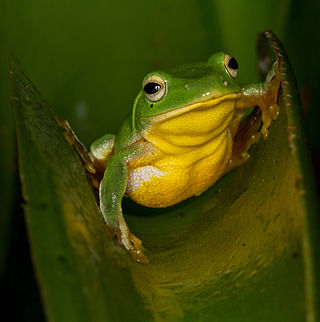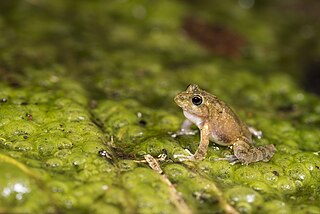
The golden banana frog, golden dwarf reed frog, golden spiny reed frog, or golden leaf-folding frog is a species of frog in the family Hyperoliidae. It is found in lowland coastal plains of eastern South Africa, Eswatini, and southern Mozambique. The AmphibiaWeb includes Afrixalus crotalus in this species as a subspecies, whereas the Amphibian Species of the World and the IUCN Red List of Threatened Species treat A. crotalus as a full species.
Hyperolius montanus is a species of frog in the family Hyperoliidae. It is endemic to Kenya and known from the Kenya Highlands. It might represent more than one species.

Nidirana adenopleura is a species of frog in the family Ranidae. It is found in Taiwan, south-eastern China, and in the Yaeyama Islands. Populations from Yaeyama Islands might represent a distinct, as yet undescribed species. The records from Vietnam and Thailand are uncertain.

The common green frog is a frog species of in the true frog family Ranidae; some sources still use the old name Rana erythraea. It lives in Southeast Asia and is also known as green paddy frog, red-eared frog or leaf frog. The last name, however, commonly refers to the Neotropical tree frogs which make up the subfamily Phyllomedusinae. These are not closely related to H. erythraea, belonging to family Hylidae instead.

Hylarana guentheri is a species of frog in the family Ranidae. It was formerly placed in the genus Rana. It is found in China, Hong Kong, Macau, Taiwan, Vietnam, and possibly Cambodia and Laos. An introduced population is found on Guam. It can live as high as 1100 meters above sea level. An alternate common name is Günther's Amoy frog, and the honorific is often spelled "Guenther's".

Hylarana latouchii, also known as Kuatun frog, La Touche's frog, or broad-folded frog, is a species of frog in the family Ranidae. It was formerly placed in genus Rana. The specific name honours the collector of the type series: "Hylarana" latouchii was described by George Albert Boulenger based on three specimens collected by Irish ornithologist John D. La Touche in Guadun village in Wuyishan, Fujian, China.

Hylarana tytleri is a frog species in the family Ranidae. It is found in eastern and northeastern India, Myanmar, Bangladesh, and southern Nepal, and possibly at lower elevations in Bhutan. It was formerly placed in Rana, and included in the common green frog. It is probably a close relative of that species nonetheless, and thus placed in the revalidated genus Hylarana, of which H. erythraea is the type species. Common name Theobald's ranid frog has been coined for it, although common names for Indian frogs previously identified as Rana erythraea include yellow-striped frog, leaf frog, and leaping frog.

Buergeria robusta is a species of frog in the family Rhacophoridae. It is sympatric with Buergeria japonica but is much larger in size.

Kurixalus idiootocus is a small species of frog in the family Rhacophoridae. It is endemic to Taiwan and is commonly known as the temple tree frog. Its natural habitats are subtropical or tropical moist shrubland, seasonally wet or flooded lowland grassland, freshwater marshes, intermittent freshwater marshes and irrigated land. It is listed as being of "Least Concern" by the IUCN although there may be some destruction of its habitat.

Zhangixalus prasinatus is a species of frog in the family Rhacophoridae endemic to northern Taiwan. It has been observed between 400 and 600 meters above sea level.

The Taipei tree frog is a species of frog in the family Rhacophoridae. It is endemic to central and northern Taiwan. It is a medium-sized tree frog; females are 4.5–5.5 cm (1.8–2.2 in) in snout-vent length, and males are slightly smaller 3.5–4.5 cm (1.4–1.8 in).

Hylarana macrodactyla is a species of frog in the family Ranidae. It is also known as the Guangdong frog, three-striped grass frog and the marbled slender frog.

Hylarana, commonly known as golden-backed frogs, is a genus of true frogs found in tropical Asia. It was formerly considered highly diverse, containing around 84 to 96 valid species, but taxonomic revision resulted in a major change in the contents of the genus, and today it is recognised as containing just four species.

Chalcorana megalonesa is a species of true frog in the family Ranidae, the "true frogs". It is endemic to Borneo and is known from both Malaysia and Indonesia (Kalimantan). It was split off from Rana chalconota in 2009 by Robert Inger and colleagues, along with a number of other species. Common name large white-lipped frog has been coined for it.

Pristimantis attenboroughi, also known as Attenborough's rubber frog, is a species of frog in the family Strabomantidae. It is endemic to the Peruvian Andes and has been recorded in and near the Pui–Pui Protection Forest. It is the first amphibian named after David Attenborough. It was discovered by Edgar Lehr and Rudolf von May during a period of two years of studying the forests of Peru. The species description was based on 34 specimens caught at elevations of 3,400–3,936 m (11,155–12,913 ft) above sea level.

Indosylvirana serendipi, or the Sri Lankan golden-backed frog, is a species of frog in the family Ranidae. It is endemic to Sri Lanka.

Buergeria choui is a species of frog in the family Rhacophoridae. Prior to its description in 2020, it was confused with Buergeria japonica. It is found in northwestern Taiwan and in the southern part of the Ryukyu Archipelago, Japan, specifically on the Yaeyama Islands. Common name Yaeyama Kajika frog has been proposed for it. The specific name choui honors Wen-Hao Chou from the National Museum of Natural Science (Taiwan), the first person to pay attention to the variation within the former Buergeria japonica.
Shuanglianpi Wetland is a partially protected natural area in Yilan County in northern Taiwan. Situated 470 meters above sea-level, it contains a botanically rich, shallow lake, which, from the perspective of plant species density, is considered to be a wetland with global significance by the Forestry Bureau of Taiwan.

















